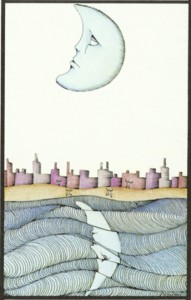The Arising of Body and Mind
 The next link in the chain of Dependent Origination is nama-rupa, which usually is translated either as “name-and-form” or “mentality-materiaity.” Christina Feldman uses “mind-and-body.” She says, “Nama, or ‘mind,’ describes the feelings, the perceptions, the intentions, the kind of attention that we give to what appears in the field of our awareness.” So nama is the whole movement of mind in all its components in relationship to the “body” of physical/material phenomena (rupa). The way it works is that “there’s the arising of rupa and then nama creates concepts or attitudes about it.
The next link in the chain of Dependent Origination is nama-rupa, which usually is translated either as “name-and-form” or “mentality-materiaity.” Christina Feldman uses “mind-and-body.” She says, “Nama, or ‘mind,’ describes the feelings, the perceptions, the intentions, the kind of attention that we give to what appears in the field of our awareness.” So nama is the whole movement of mind in all its components in relationship to the “body” of physical/material phenomena (rupa). The way it works is that “there’s the arising of rupa and then nama creates concepts or attitudes about it.
Christina continues, “The kind of relationship we have with any rupa, including our own body, is shaped by what’s going on in the mind, whether we are aware of it or not.
“So the shape of the mind and body, this nama-rupa, is always changing, always moving, never staying the same. Consciousness, body and mind are always interdependent. Consciousness leads the body and the mind to function in a certain way. If consciousness has arisen flavored by anger or by greed, by depression, by anxiety…or whatever…it provides the conditions for the body and mind to organize itself in a particular way. We can have a sad body, an angry body, a fearful body….and that sense of body is not only what is happening physically, but also what is happening in the mind.”
I like the simplicity of “mind/body” as translation for nama/rupa, but it’s not just our own mind and body that we’re talking about. It’s all the forms that appear in awareness, and the mental response we have to them. I prefer “mentality/materiality,” but it’s too much of a mouthful. I’m tempted to go with “things-and-thoughts,” for the alliteration if nothing else. But that suggests too much of a split. The physical “thing” is inseparable from our mental response to it. (As in the image I chose of the moon and its reflection.) I like the way nama suggests “name,” so for the homework assignment, I’ll go with “name-and-form.”
(image: Maddonni Tarot)
